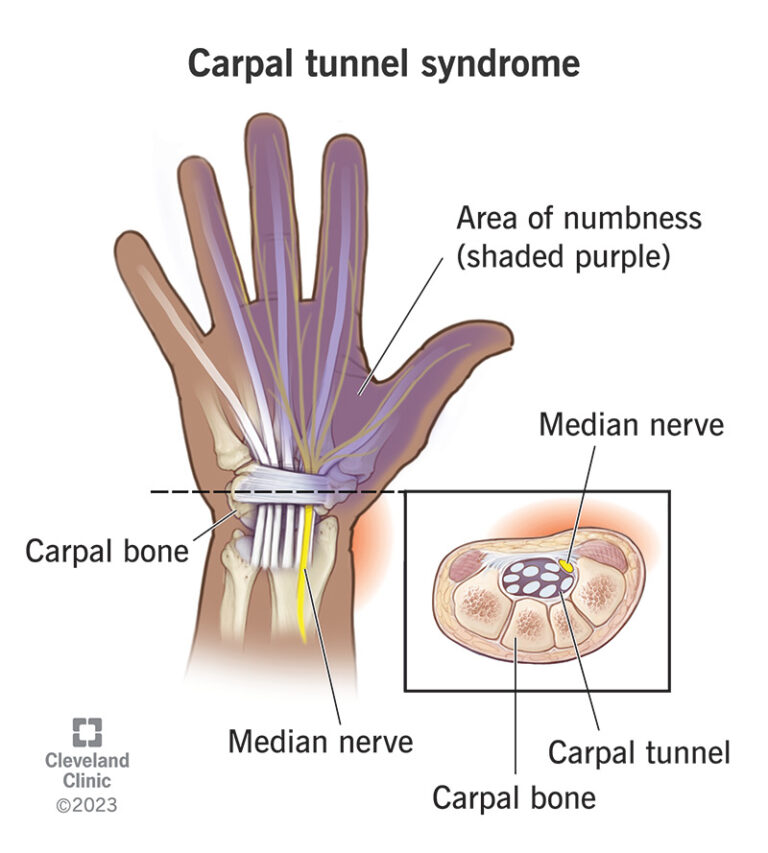
Carpal Tunnel Syndrome (CTS) is a condition that occurs when the median nerve, which runs from the forearm into the palm of the hand, becomes compressed or squeezed at the wrist. This nerve controls sensations to the palm side of the thumb and fingers (except the little finger), as well as impulses to some small muscles in the hand that allow the fingers and thumb to move. The carpal tunnel is a narrow, rigid passageway of ligament and bones at the base of the hand, housing the median nerve and tendons. Thickening or swelling of irritated tendons or other swelling can reduce the space within the tunnel, causing the median nerve to become compressed.
Carpal tunnel syndrome can result from a variety of factors that cause increased pressure on the median nerve and tendons in the carpal tunnel. Contributing factors include the anatomy of the wrist, underlying health conditions, and possibly patterns of hand use. For instance, repetitive hand movements, especially those involving bending the wrist or gripping, can lead to or exacerbate the condition. Other risk factors include diabetes, rheumatoid arthritis, thyroid dysfunction, fluid retention from pregnancy or menopause, and wrist fractures or dislocations.
The symptoms of carpal tunnel syndrome typically start gradually, with frequent burning, tingling, or itching numbness in the palm of the hand and the fingers, especially the thumb and the index and middle fingers. Some people with CTS find it difficult to form a fist, grasp small objects, or perform other manual tasks. As symptoms worsen, people might feel tingling during the day, and decreased grip strength can make it difficult to perform tasks like buttoning clothes. In severe cases, untreated carpal tunnel syndrome can lead to permanent nerve damage and muscle atrophy.
Diagnosis of carpal tunnel syndrome involves a combination of patient history, physical examination, and diagnostic tests. The physical examination focuses on the sensation in the fingers and the strength of the muscles in the hand. Doctors may use specific tests like the Tinel test, where the doctor taps over the median nerve to see if it causes a tingling sensation in the fingers, and the Phalen test, where the patient presses the backs of the hands together with fingers pointing down to see if it triggers symptoms. Electromyography (EMG) and nerve conduction studies (NCS) are often used to confirm the diagnosis and assess the severity of the condition.
Treatment options for carpal tunnel syndrome vary depending on the severity of the symptoms and how long the condition has persisted. For mild to moderate cases, non-surgical treatments can be effective. These include wrist splinting, especially at night, nonsteroidal anti-inflammatory drugs (NSAIDs), and corticosteroid injections to reduce inflammation. Physical therapy and ergonomic changes to reduce strain on the wrist and hand can also be beneficial. For severe cases or when symptoms do not respond to conservative treatments, surgical intervention may be necessary. Carpal tunnel release surgery involves cutting the ligament pressing on the median nerve to relieve the pressure and can be performed using traditional open techniques or endoscopic methods.
Carpal tunnel syndrome can significantly impact daily activities and quality of life if left untreated. Early diagnosis and intervention are crucial to prevent permanent nerve damage. For those in need of expert care, consulting a specialist, such as a neurosurgeon in Indore, can provide a comprehensive evaluation and tailored treatment plan to manage and alleviate symptoms effectively.

Carpal tunnel syndrome (CTS) is a medical condition that results from the compression of the median nerve as it travels through the carpal tunnel in the wrist. The carpal tunnel is a narrow, rigid passageway of ligament and bones located at the base of the hand, housing the median nerve and the tendons that control finger movement. When the tissues around the tendons in the wrist swell, they can press on the median nerve, leading to the characteristic symptoms of carpal tunnel syndrome.
The median nerve provides sensation to the thumb, index finger, middle finger, and part of the ring finger. It also controls some of the small muscles at the base of the thumb. When the median nerve is compressed, it can result in pain, numbness, and tingling in the hand and arm.
Several factors can contribute to the development of carpal tunnel syndrome, including:
The symptoms of carpal tunnel syndrome usually start gradually and can include:
Diagnosis involves a combination of medical history, physical examination, and tests. The doctor may perform specific maneuvers to elicit symptoms, such as the Tinel’s sign and Phalen’s maneuver. Diagnostic tests like electromyography (EMG) and nerve conduction studies can help confirm the diagnosis and determine the severity of the condition.
Treatment options vary depending on the severity of symptoms:
Non-surgical Treatments:
Surgical Treatment:
In conclusion, carpal tunnel syndrome is a prevalent condition that can severely affect one’s daily life and overall well-being if not addressed promptly. The symptoms, ranging from tingling and numbness to pain and weakness, can hinder everyday activities and lead to significant discomfort. Early diagnosis and intervention are crucial to prevent permanent nerve damage and restore functionality. For those experiencing symptoms of carpal tunnel syndrome, seeking medical advice is essential. Consulting with a neurosurgeon in Indore, such as Dr. Amit Deora, ensures expert diagnosis and tailored treatment, providing comprehensive care to alleviate symptoms and improve quality of life.